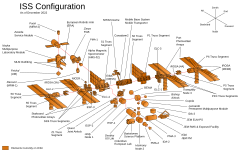
Back Internasionale Ruimtestasie Afrikaans Estación Espacial Internacional AN محطة الفضاء الدولية Arabic আন্তৰ্জাতিক মহাকাশ কেন্দ্ৰ Assamese Estación Espacial Internacional AST Beynəlxalq Kosmik Stansiya Azerbaijani Міжнародная касмічная станцыя Byelorussian Міжнародная касьмічная станцыя BE-X-OLD Международна космическа станция Bulgarian इंटरनेशनल स्पेस इस्टेशन Bihari
 Oblique underside view in November 2021 | |
 International Space Station programme emblem with flags of the original signatory states[1] | |
| Station statistics | |
|---|---|
| COSPAR ID | 1998-067A |
| SATCAT no. | 25544 |
| Call sign | Alpha, Station |
| Crew |
|
| Launch | 20 November 1998 |
| Launch pad | |
| Mass | 450,000 kg (990,000 lb)[2] |
| Length | 109 m (358 ft) (overall), 94 m (310 ft) (truss)[3] |
| Width | 73 m (239 ft) (solar array)[3] |
| Pressurised volume | 1,005.0 m3 (35,491 cu ft)[3] |
| Atmospheric pressure | 1 atm (101.3 kPa; 14.7 psi) 79% nitrogen, 21% oxygen |
| Perigee altitude | 413 km (256.6 mi) AMSL[4] |
| Apogee altitude | 422 km (262.2 mi) AMSL[4] |
| Orbital inclination | 51.64°[4] |
| Orbital speed | 7.67 km/s; 27,600 km/h; 17,100 mph[5] |
| Orbital period | 92.9 minutes[6] |
| Orbits per day | 15.5[4] |
| Orbit epoch | 16 August 16:19:30[7] |
| Days in orbit | 26 years, 1 month, 22 days as of 11 January 2025 |
| Days occupied | 24 years, 2 months, 9 days as of 11 January 2025 |
| No. of orbits | 141,117 as of August 2023[update][7] |
| Orbital decay | 2 km/month (1.2 mi/month) |
| Statistics as of 22 December 2022 (unless noted otherwise) References:[3][4][8][9][10] | |
| Configuration | |
 | |
The International Space Station (ISS) is a large space station that was assembled and is maintained in low Earth orbit by a collaboration of five space agencies and their contractors: NASA (United States), Roscosmos (Russia), ESA (Europe), JAXA (Japan), and CSA (Canada). As the largest space station ever constructed, it primarily serves as a platform for conducting scientific experiments in microgravity and studying the space environment.[11]
The station is divided into two main sections: the Russian Orbital Segment (ROS), developed by Roscosmos, and the US Orbital Segment (USOS), built by NASA, ESA, JAXA, and CSA. A striking feature of the ISS is the Integrated Truss Structure, which connect the station’s vast system of solar panels and radiators to its pressurized modules. These modules support diverse functions, including scientific research, crew habitation, storage, spacecraft control, and airlock operations. The ISS has eight docking and berthing ports for visiting spacecraft. The station orbits the Earth at an average altitude of 400 kilometres (250 miles)[12] and circles the Earth in roughly 93 minutes, completing 15.5 orbits per day.[13]
The ISS programme combines two previous plans to construct crewed Earth-orbiting stations: the United States' Space Station Freedom and the Soviet Union's Mir-2. The first ISS module was launched in 1998, with major components delivered by Proton and Soyuz rockets and the Space Shuttle. Long-term occupancy began on 2 November 2000, with the arrival of the Expedition 1 crew. Since then, the ISS has remained continuously inhabited for 24 years and 70 days, the longest continuous human presence in space. By March 2024[update], 279 individuals from 22 countries had visited the station.[14]
Future plans for the ISS include the addition of at least one module, Axiom Space's Payload Power Thermal Module. The station is expected to remain operational until the end of 2030, after which it will be de-orbited using a dedicated NASA spacecraft.[15]
- ^ "ISS logos executive summary". www.esa.int. European Space Agency. Archived from the original on 23 March 2024. Retrieved 4 December 2024.
- ^ "ISS: International Space Station". Archived from the original on 10 August 2023.
- ^ a b c d Garcia, Mark (5 January 2023). "About the Space Station: Facts and Figures". NASA. Archived from the original on 6 February 2023. Retrieved 13 January 2023.
- ^ a b c d e Peat, Chris (21 May 2021). "ISS – Orbit". Heavens-Above. Archived from the original on 25 December 2018. Retrieved 21 May 2021.
- ^ "Live Space Station Tracking Map". NASA. Archived from the original on 10 May 2024. Retrieved 2 May 2024.
- ^ Holman, Joseph (12 October 2022). "ISS (ZARYA)". Satellite Tracking. Archived from the original on 12 October 2022. Retrieved 12 October 2022.
- ^ a b "ARISS TLE". ARISS TLE. 16 August 2023. Archived from the original on 2 April 2023. Retrieved 16 August 2023.
- ^ Cite error: The named reference
OnOrbitwas invoked but never defined (see the help page). - ^ "STS-132 Press Kit" (PDF). NASA. 7 May 2010. Archived (PDF) from the original on 12 October 2023. Retrieved 19 June 2010.
- ^ "STS-133 FD 04 Execute Package" (PDF). NASA. 27 February 2011. Archived from the original (PDF) on 27 November 2020. Retrieved 27 February 2011.
- ^ "ISS". nasa.gov. 23 May 2023. Archived from the original on 16 May 2024. Retrieved 9 May 2024.
- ^ "NASA – Higher Altitude Improves Station's Fuel Economy". nasa.gov. 14 February 2019. Archived from the original on 25 December 2021. Retrieved 29 May 2019.
- ^ "Current ISS Tracking data". NASA. 15 December 2008. Archived from the original on 25 December 2015. Retrieved 28 January 2009.
 This article incorporates text from this source, which is in the public domain.
This article incorporates text from this source, which is in the public domain.
- ^ "International Space Station Visitors by Country – NASA". Archived from the original on 23 January 2024. Retrieved 19 March 2023.
- ^ "NASA Selects International Space Station US Deorbit Vehicle – NASA". Retrieved 26 June 2024.